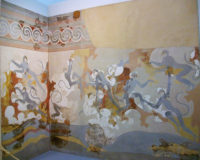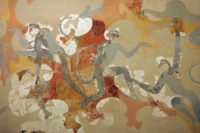 Monkeys depicted in a wall painting from the Late Cycladic I period (17th century B.C.) in Akotiri on the Greek island of Thera have been identified as grey langurs, a species native to southern Asia thousands of miles from Minoan Thera.
Monkeys depicted in a wall painting from the Late Cycladic I period (17th century B.C.) in Akotiri on the Greek island of Thera have been identified as grey langurs, a species native to southern Asia thousands of miles from Minoan Thera.
The fresco decorates the north and west walls in a room of a building dubbed Beta 6. The monkeys climb and frolic above undulating bands of blue that likely represent water, using the rocks that emerge from the waves as jumping off points for their simian games. Its composition, dynamism and bold lines convey a natural setting with an almost abstract restraint. It is known as the Blue Monkey fresco — the color of the monkeys match the waters beneath them — but they’re definitely a slate blue in the greyish family.
Marie Nicole Pareja at the University of Pennsylvania in Philadelphia teamed up with primatologists to re-examine the mystery monkey paintings. One stood out. “When they looked at this wall painting, they all straight away unambiguously said ‘that’s a langur’,” says Pareja.
The team has identified the monkey as a grey langur (Semnopithecus). As well as its distinctive fur, the monkey was depicted holding its tail in a characteristic S shape.
Grey langurs live in southern Asia in what is now Nepal, Bhutan and India – and particularly in the Indus Valley. During the Bronze Age, the region was home to the Indus Valley Civilisation, one of the most important societies of that time. Although it was past its peak, the Indus Valley Civilisation was still advanced for its time, with large cities and elaborate water supply systems.
 As there were no native species of monkey in Bronze Age Greece, it was always known that these lively fellows were exotic imports. However, most artwork from the period that features monkeys involve species native to Egypt, which was far closer to home and had an established trade network with ancient Greece.
As there were no native species of monkey in Bronze Age Greece, it was always known that these lively fellows were exotic imports. However, most artwork from the period that features monkeys involve species native to Egypt, which was far closer to home and had an established trade network with ancient Greece.
Did Minoan Greeks visit the Indus? “I wouldn’t be surprised if someday in the future we found evidence for that kind of direct contact,” says Pareja, but right now there is none. It is also possible the visit was the other way round, but again there is no evidence.
Instead, it may be that Greece and Indus were connected via Mesopotamia, another Bronze Age civilisation centred on what is now Iraq. Langurs may have been imported to Mesopotamia for menageries, where visiting Greeks saw them.
“It’s evidence of this far-reaching trade, these relationships with these far-flung areas,” says Pareja. Even in the Bronze Age, it seems there was a lot of exchange between seemingly separate civilisations.